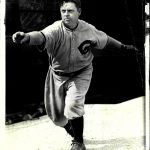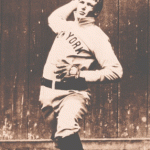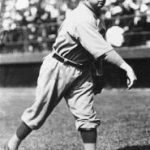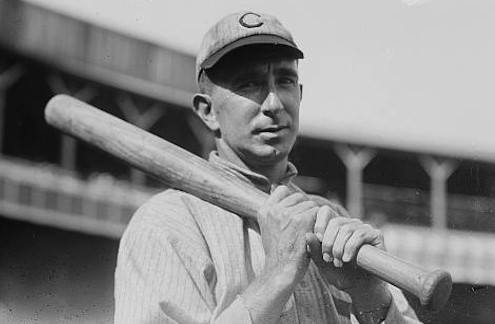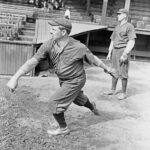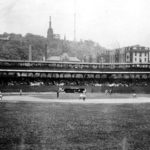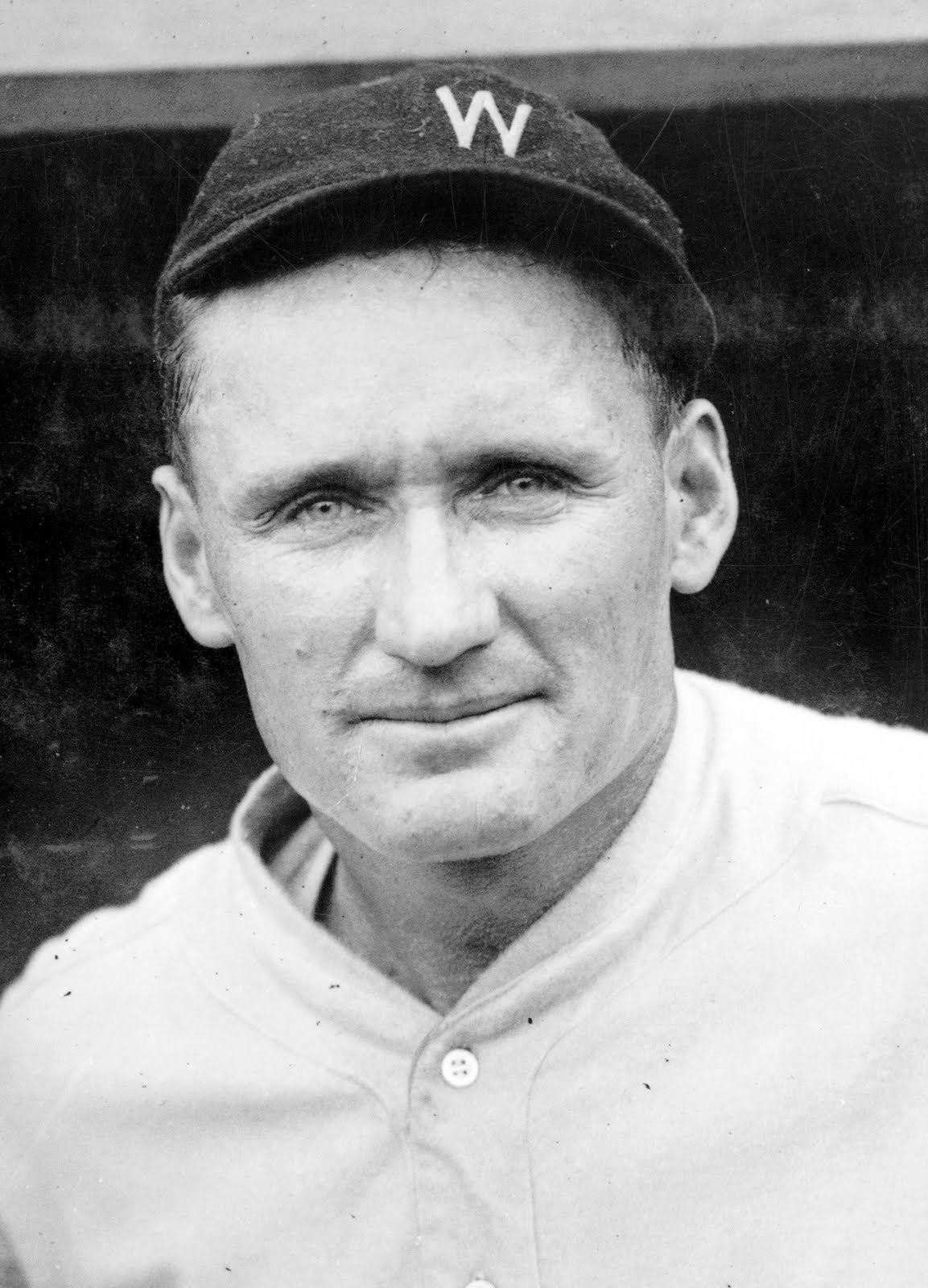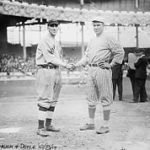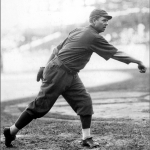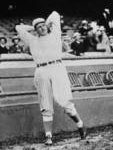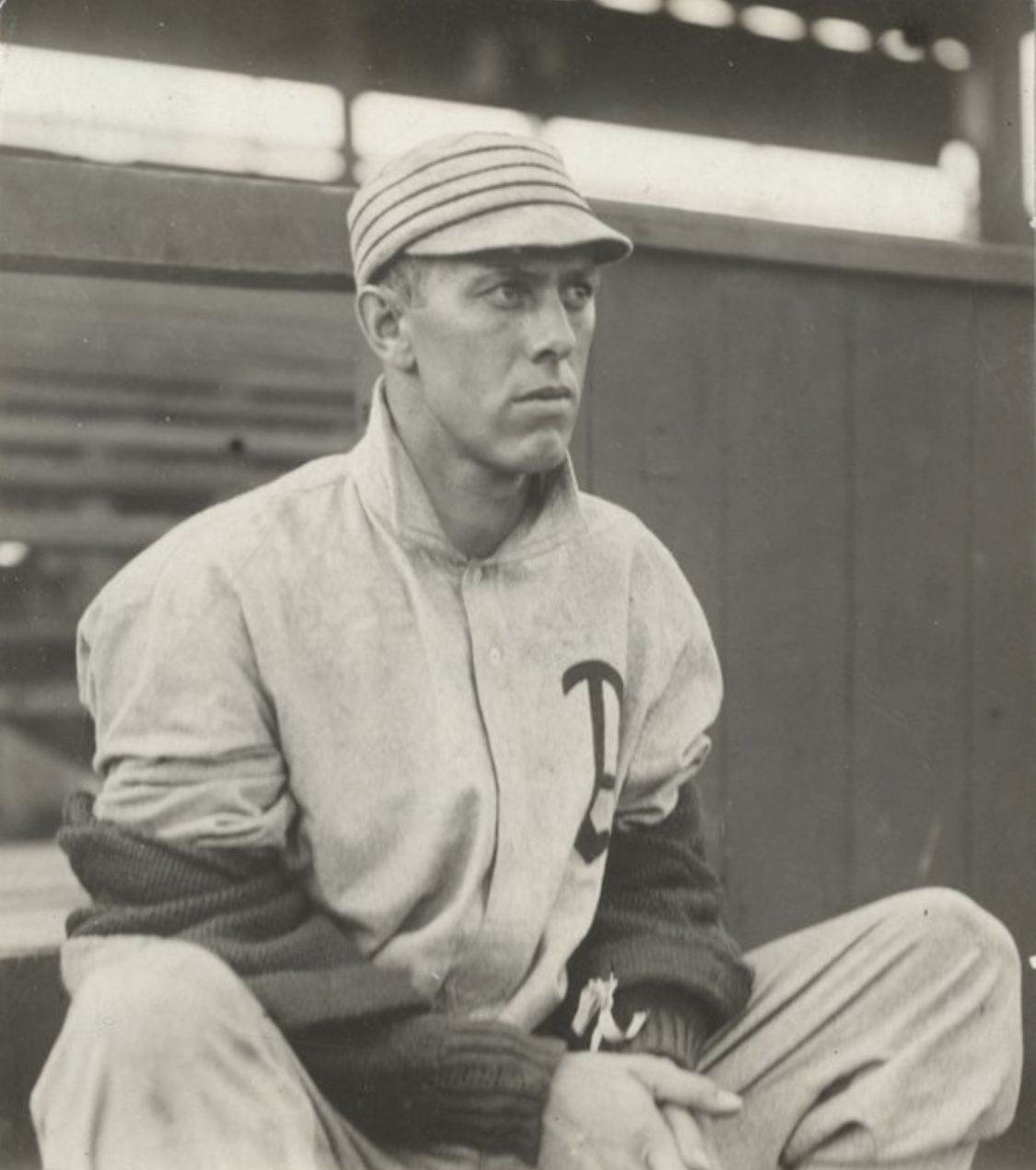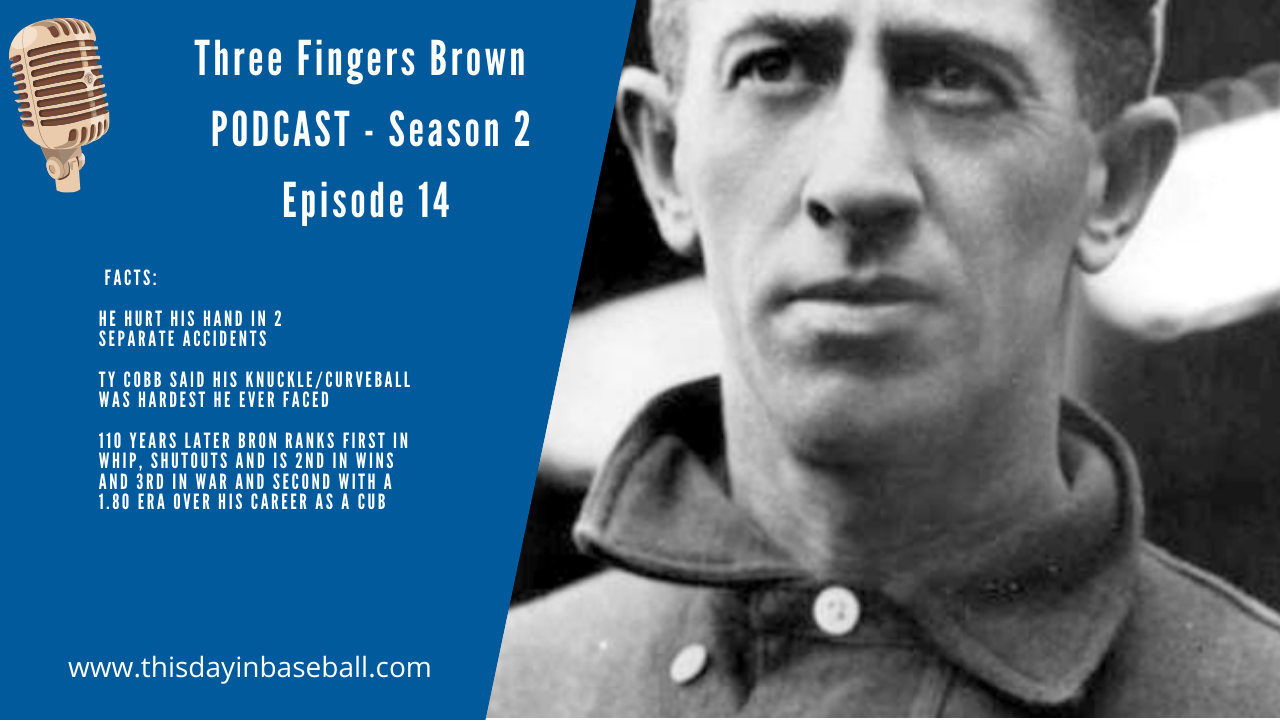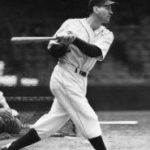Mordecai Brown Essentials
Positions: Pitcher
Bats: B Throws: R
Height: 5′-10″ Weight: 175
Born: October 19, 1876 in Nyesville, IN us
Died: February 14, 1948 in Terre Haute, IN
Buried: Roselawn Memorial Park, Terre Haute, IN
High School: Nyesville HS (Nyesville, IN)
Debut: April 19, 1903
Last Game: September 4, 1916
vs. CIN 9.0 IP, 19 H, 2 SO, 1 BB, 9 ER, L
Hall of Fame: Inducted as Player in 1949. (Voted by Old Timers Committee)
View Mordecai Brown’s Page at the Baseball Hall of Fame (plaque, photos, videos).
Full Name: Mordecai Peter Centennial Brown
Nicknames: Three Finger or Miner
View Player Bio from the SABR BioProject
Nine Players Who Debuted in 1903
John Titus
Hans Lobert
Solly Hofman
Lee Tannehill
George Moriarty
Jake Stahl
Three-Finger Brown
Chief Bender
Red Ames
The Mordecai Brown Teammate Team
C: Johnny Kling
1B: Frank Chance
2B: Johnny Evers
3B: Harry Steinfeldt
SS: Joe Tinker
LF: Jimm Sheckard
CF: Max Flack
RF: Frank Schulte
SP: Ed Reulbach
SP: Red Ames
SP: George McConnell
SP: Hippo Vaughn
M: Frank Chance
Notable Events and Chronology for Three Fingers Brown Career
Spending his entire career pitching in the shadow of the great Christy Mathewson prevented Mordecai “Three-Fingered” Brown from garnering the type of accolades he otherwise would have received. Nevertheless, Brown rivaled Mathewson as baseball’s premier hurler for much of the first decade of the 20th century, establishing himself in the process as one of the Deadball Era’s greatest pitchers. Brown compiled a record of 127-44 for the Chicago Cubs from 1906 to 1910, posting an ERA well below 2.00 each year, and leading the Cubs to three pennants and two world championships. During that five-year stretch, Brown led all National League pitchers in wins, ERA, and innings pitched once each, and in complete games and shutouts two times each. He accomplished all he did despite pitching with a badly mangled right hand he injured during a childhood accident.
Biography:
Born in Nyesville, Indiana on October 19, 1876, Mordecai Peter Centennial Brown owed his unusually long name to his year of birth, which marked the first American Centennial. Brown’s life changed forever at the age of seven, when he caught the index finger on his right hand in his uncle’s corn shredder, forcing him to have it amputated above the knuckle. Just a few weeks later, Brown reinjured the same hand chasing a pig, breaking the two middle fingers and injuring the pinky finger as well. The broken fingers healed badly, and the pinky finger remained paralyzed. Yet, Brown eventually turned his handicap into an advantage, learning that the unusual manner with which he gripped a baseball forced it to move in an extremely unconventional manner.
Brown first learned to pitch by aiming rocks at knotholes on the barn wall and other wooden surfaces on his parents’ farm. He later decided to pursue a career in baseball while working in the coal mines of western Indiana as a teenager – a period of his life that also earned him the nickname “Miner.” With the encouragement of a co-worker, Brown learned to grip and toss a baseball with his injured hand. Brown’s tremendous determination enabled him to overcome the initial pain he felt whenever he handled the ball, and he eventually came to realize that his unorthodox grip gave his pitches a natural downward movement. In addition to his extraordinary curveball/sinker, Brown developed an extremely effective fastball and change-up.
Having perfected his pitching repertoire, Brown began his minor league career in Terre Haute of the Three-I League in 1901. After dominating minor league hitters for two years, Brown joined the St. Louis Cardinals in 1903, at the somewhat advanced age of 26. He spent one year in St. Louis, compiling a record of only 9-13, before being dealt to the Chicago Cubs prior to the start of the 1904 campaign.
Brown flourished in Chicago, winning a total of 33 games in his first two seasons with his new team, while also posting ERAs of 1.86 and 2.17, respectively. He then began the most successful run of his career in 1906, leading the Cubs to the first of three straight National League pennants by posting a record of 26-6, a league-leading nine shutouts, and a 20th century-best 1.04 ERA. Although the Cubs failed to win the World Series, they captured the next two world championships, with Brown serving as the ace of their pitching staff, and as the team’s most important player. He finished 20-6 in 1907, with an ERA of 1.39 and 20 complete games. Brown followed that up by going 29-9 in 1908, with a 1.47 ERA, 27 complete games, nine shutouts, and 312 innings pitched.
Brown pitched one of the most significant games of his career on the final day of that 1908 campaign, relieving faltering Cubs starter Jack Pfiester during the early stages of the pennant-deciding contest played between Chicago and the New York Giants. Facing the great Christy Mathewson, Brown held the Giants in check the rest of the way, enabling the Cubs to win the game 4-2, thereby capturing their second straight league championship. He then led the Cubs to their second consecutive World Series victory by winning two games and throwing 11 scoreless innings against Ty Cobb’s Detroit Tigers in the Fall Classic. Brown also tossed a complete-game shutout against Detroit in the previous year’s World Series, giving him a record of 3-0, with 20 consecutive scoreless innings pitched against the Tigers in postseason play.
Brown’s performance against Detroit so impressed Ty Cobb that the Tigers outfielder later proclaimed, “‘Miner’ Brown is one of the greatest pitchers in the history of baseball, and a remarkable fielder at all times.”
New York Giants manager John McGraw was another who greatly admired Brown, regarding the Chicago righthander and his own Christy Mathewson as the two best pitchers in the National League. Mathewson, himself, expressed his admiration for his rival when he stated, “Brown is my idea of the almost perfect pitcher…It will usually be found at the end of a season that he has taken part in more key games than any other pitcher in baseball.”
Over the course of their careers, Mathewson and Brown faced each other a total of 25 times in head-to-head competition, with Brown holding a slim 13-11 edge, including one no-decision. Most of those contests turned out to be classic pitching duels, with both men stifling the offenses of their opponents. Chicago player-manager Frank Chance felt extremely confident any time Brown took the mound, even against superb pitchers such as Mathewson. The Hall of Fame first baseman suggested, “Let’s get one run ahead with Brown in the box, and we are sure to win.”
Orval Overall, another member of Chicago’s starting rotation, marveled at the determination and poise Brown consistently displayed on the mound, saying: “Brown, to my way of thinking, is the most courageous pitcher in the history of baseball….Cool as a deep-sea fish and brave as a lion, nothing fazes him.”
Although the Cubs failed to win another world championship after 1908, Brown continued to pitch at an extremely high level. He led the National League with a record of 27-9 in 1909, while compiling an ERA of 1.31 and tossing eight shutouts. He also topped the circuit with 32 complete games, 343 innings pitched, and seven saves. Brown performed brilliantly again in 1910, finishing the year with a record of 25-14, an ERA of 1.86, 295 innings pitched, and a league-leading 27 complete games, six shutouts, and seven saves. He had his last big year in 1911, posting a record of 21-11, along with a 2.80 ERA, 21 complete games, 270 innings pitched, and a league-leading 13 saves.
A sore arm limited Brown to only 15 appearances in 1912, bringing to an end his period of dominance. Released by the Cubs at season’s end, Brown joined Louisville of the American Association, who subsequently traded the 36-year-old hurler to the Cincinnati Reds. After finishing just 11-12 for Cincinnati in 1913, Brown jumped to the St. Louis Terriers of the rival Federal League. He spent the next two years in the circuit, splitting his time between St. Louis, Brooklyn, and Chicago, and compiling a combined record of 31-19. The Chicago Cubs reacquired Brown prior to the start of the 1916 campaign, and the 39-year-old righthander spent his final season with the team with whom he experienced his greatest success. He retired at season’s end with a career record of 239-130 and an ERA of 2.06, the third best in major league history, behind only Ed Walsh and Addie Joss. Over the course of his career, Brown surpassed 20 victories six times, winning at least 25 games on four separate occasions. He also compiled an ERA below 2.00 six different times, and he completed more than 20 games eight times. In addition to leading the National League in wins and earned run average one time each, he finished second in each category three times. Brown also topped the circuit in saves four times.
Following his retirement from the majors, Brown returned to his home in Terre Haute, where he continued to pitch in the minor leagues and in exhibition games for more than a decade, as well as coaching and managing. From 1920 to 1945, he ran a filling station in Terre Haute that also served as a town gathering place and an unofficial museum. He also was a frequent guest at Old-Timers’ games in Chicago. Brown spent his later years plagued by diabetes, before finally suffering a stroke. He died in 1948, gaining admission to the Baseball Hall of Fame posthumously the following year.
Although the childhood injuries Brown suffered likely would have discouraged most people from pursuing a career in any professional sport, the Hall of Fame pitcher possessed the will and determination that eventually enabled his handicap to work for him in a positive way. Brown later recalled, “That old paw served me pretty well in its time. It gave me a firmer grip on the ball, so I could spin it over the hump. It gave me a greater dip.”
Best Season: 1906
The Cubs allowed just 383 runs the entire season, with Brown’s 1.04 ERA leading the way. He won 26 games and allowed just one home run all season.
Pitching Duels
In an era of low scoring games, Brown was a staff ace who often faced the other team’s best arm. Consequently, Brown often faced the Giants’ Christy Mathewson, Pittsburgh’s Babe Adams, Philadelphia’s Pete Alexander, Brooklyn’s Nap Rucker and the Braves’ Vic Willis. A fantastic study would be to research the head-to-head record of these great pitching legends. Mathewson and Brown faced each other 25 times in their careers, “Three-Finger” posting a 13-10 record, Matty going 11-13. Here are some of their memorable moments: On June 13, 1905, Brown carried a two-hitter into the ninth inning against Matty, only to allow four straight hits and lose 1-0. Mathewson hurled a no-hitter for the win. In July of that same season Brown defeated Matty and began a streak of eight straight wins over the Giants’ legend. On July 17, 1908, Matty lost 1-0 to Brown when Cubs’ shortstop Joe Tinker hit an inside-the-park homer in the fifth inning. In one of the most bizarre games ever played, Brown and Matty hook up on September 23, 1908 in the Polo Grounds. With the score locked 1-1 in the bottom of the ninth, Giants’ shortstop Al Bridwell hit an RBI_single, apparently winning the game. But the runner on first, Fred Merkle, failed to touch second base and Cubs’ second baseman Johnny Evers alertly tagged the bag, nullifying the run. After haggling and protests, the game was declared a tie. At the end of the season it is replayed and the Cubs win to take the pennant. Brown defeated Mathewson in the rematch. On July 15, 1913, Mathewson defeated Brown (now with the Reds) 4-2 and ran his streak of innings without a walk to 61. In 1916, their best years behind them, Brown (back with the Cubs) and Mathewson agreed to face each other in the second game of the Labor Day doubleheader. The game was to be the final appearance for either man in a big league uniform and it was designed as a publicity stunt. Mathewson, now managing the Reds, got the win in a 10-8 contest. Brown lost to finish 13-10 against the great pitcher.
Factoids, Quotes, Milestones and Odd Facts
Played For
St. Louis Cardinals (1903)
Chicago Cubs (1904-1912)
Cincinnati Reds (1913)
St. Louis Terriers (1914)
Brooklyn Tip-Tops (1914)
Chicago Whales (1915)
Chicago Cubs (1916)
Managed
St. Louis Terriers (1914)
Similar: Chief Bender, Jim Abbott
Nicknames: Three Finger,Miner
Brown was known as “Cuy” as a kid. In the big leagues he was known as “Three-Fingered” or “Three-Finger” Brown.
Best Season, 1906
The Cubs allowed just 383 runs the entire season, with Brown’s 1.04 ERA leading the way. He won 26 games and allowed just one home run all season.
Post-Season Appearances
1906 World Series
1907 World Series
1908 World Series
1910 World Series
Where He Played: Starting pitcher, and reliever when needed.
Transactions
Traded by St. Louis Cardinals with Jack O’Neill to Chicago Cubs in exchange for Jack Taylor and Larry McLean (December 12, 1903).
Pitching Duels
In an era of low scoring games, Brown was a staff ace who often faced the other team’s best arm. Consequently, Brown often faced the Giants’ Christy Mathewson, Pittsburgh’s Babe Adams, Philadelphia’s Pete Alexander, Brooklyn’s Nap Rucker and the Braves’ Vic Willis. A fantastic study would be to research the head-to-head record of these great pitching legends. Mathewson and Brown faced each other 25 times in their careers, “Three-Finger” posting a 13-10 record, Matty going 11-13. Here are some of their memorable moments: On June 13, 1905, Brown carried a two-hitter into the ninth inning against Matty, only to allow four straight hits and lose 1-0. Mathewson hurled a no-hitter for the win. In July of that same season Brown defeated Matty and began a streak of eight straight wins over the Giants’ legend. On July 17, 1908, Matty lost 1-0 to Brown when Cubs’ shortstop Joe Tinker hit an inside-the-park homer in the fifth inning. In one of the most bizarre games ever played, Brown and Matty hook up on September 23, 1908 in the Polo Grounds. With the score locked 1-1 in the bottom of the ninth, Giants’ shortstop Al Bridwell hit an RBI_single, apparently winning the game. But the runner on first, Fred Merkle, failed to touch second base and Cubs’ second baseman Johnny Evers alertly tagged the bag, nullifying the run. After haggling and protests, the game was declared a tie. At the end of the season it is replayed and the Cubs win to take the pennant. Brown defeated Mathewson in the rematch. On July 15, 1913, Mathewson defeated Brown (now with the Reds) 4-2 and ran his streak of innings without a walk to 61. In 1916, their best years behind them, Brown (back with the Cubs) and Mathewson agreed to face each other in the second game of the Labor Day doubleheader. The game was to be the final appearance for either man in a big league uniform and it was designed as a publicity stunt. Mathewson, now managing the Reds, got the win in a 10-8 contest. Brown lost to finish 13-10 against the great pitcher.
Best Strength as a Player
His breaking pitch, which dropped and turned in odd ways because of his mangled pitching hand.
Largest Weakness as a Player
Brown was considered easy to steal against.
Other Resources & Links


